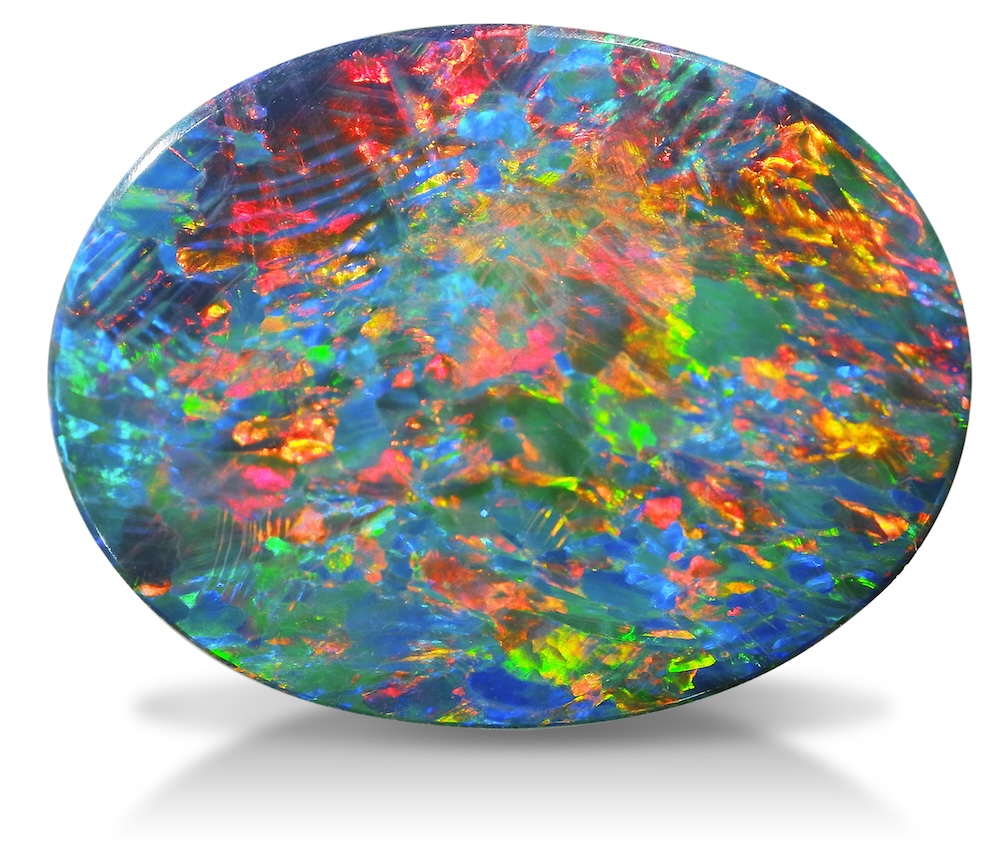FYI- SPONSORED CONTENT
Play-of-Color: A Kaleidoscopic Artist's Pallet
Wade Abel, CG, Director of Gemology, American Gem Society

Parle
black cab opal
MSRP $95,000
parlegems.com
Opals are mesmerizing gemstones with the ability to display all the colors of the spectrum when viewed from different angles. This phenomenon, known as “play-ofcolor,” is a hallmark of opal that contributes to its rarity and value. It is important to note that this phenomenon is largely unique to this gem. There are various types of opal, such as black opal and white opal, that are distinguished by the gemstone’s body color, yet each may exhibit play-ofcolor to varying degrees and in different patterns.
Optical Causes of Play-of-Color
The cause of the play-ofcolor in opals is like other phenomenal gemstones, a result of the gemstone’s internal structure. Opals comprise submicroscopic silica spheres stacked and layered in a grid-like pattern. Along with the spheres, opals can contain water, which plays an important role in creating the play-of-color phenomenon. (GeologyScience, 2023) This internal structure diffracts light, breaking up the white light as it passes through. The result is the observation of spectral colors that can shift as the viewing angle or the light source changes. The size of these silica spheres is a determining factor for the colors observed in the opal.
Omi Prive
18K pendant 1.31ct oval opal accented by tourmaline and diamonds
MSRP $20,000
bellarri.com
Patterns Created by Play-of-Color
The play-of-color patterns in opal can vary widely. Common patterns include small, closely spaced patches of color called “pinfire,” large, angular patches of color called “harlequin,” and sweeping bands of color that can look like brushstrokes called “flame.” The value of an opal is often influenced by the brightness and uniqueness of these patterns, with clear, distinct play-of-color being more highly prized.
Featuring Play-of-Color in Jewelry
Opals with play-of-color have a unique ability to catch the eye and adapt to changing lighting conditions. Opals can be paired with other colored gemstones, emphasizing the colors present. Maximizing exposure to light is important when setting opals in jewelry to increase play-of-color. They are often fashioned as cabochons that allow light to enter and interact with the stone from various angles.
Because opal is relatively soft and porous compared to other gemstones, choosing a setting that can protect it is essential. Opals can be designed as doublets, where the opal is adhered to a sturdy base material, or triplets, which include a clear gemstone protective covering and a sturdy darker backing with the opal slice in between. Both increase opal’s durability in jewelry and ease of care. This should always be disclosed when describing the gem.
Protecting this Phenomenal Gem
With any gemstone, care is crucial. For opals, care must be taken to preserve the phenomenal play-of-color effects. The presence of water makes opal susceptible to temperature changes where the expansion and contraction of the material can result in cracking. Because opal is porous, chemicals may be absorbed into the gemstone, including perfumes, household cleaners, and hairsprays. This can alter the color and reduce the phenomenon. Using a mild soap with warm water and a soft cloth or brush for cleaning is best. Avoid ultrasonic or steam cleaners, as these can cause damage due to the opal’s water content and general softness.
Omi Prive
18K pendant with 2.08ct black opal, 1.61ct moonstone, Paraíba tourmaline, and diamonds
MSRP $21,000
bellarri.com
Parle
18K Australian black opal ring with mint garnet and diamonds
MSRP $11,295
parlegems.com
An Unmatched Phenomenon
The play-of-color in opals is a testament to nature’s artistry, combining intricate internal structures with the simple yet profound physics of light diffraction. By understanding the underlying mechanisms and appreciating the delicate beauty of these patterns, jewelers and enthusiasts can better appreciate and preserve the enchanting allure of opals.
The American Gem Society (AGS) Diamond Grading Standards have provided a common language for evaluating diamond quality among AGS members and diamond buying consumers. These standards were provisional when first published in 1966 and approved by the AGS members in 1975. To this day, AGS titleholders have the ability to assess diamonds with these standards. From 1996 through 2022, the AGS Laboratories applied the AGS Diamond Grading Standards in nearly all the reporting. In the early 2000s, the cut grade standard evolved, incorporating Light Performance, and creating a way to describe and predict how light acts in the diamond. This became a catalyst for manufacturers to focus on diamond cut and work toward the AGS Ideal®. Concerns arose with the closure of the lab that programs built around this cut grade would not have continued options for differentiation integral to their marketing. Luckily, with the strengthened collaboration between AGS and GIA, the AGS Ideal® continues to be available with the AGS Ideal® Report by GIA.









